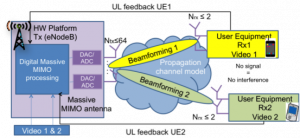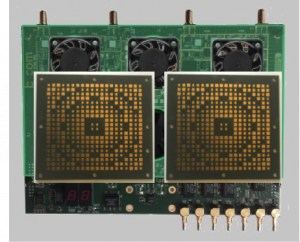According to the focus application, different system configurations have been identified. In the project, there are identified by different milestones MS.
| Rx 60 GHz front-end for SIMO channel sounding | 60 GHz front-end Wireless communication |
| MS2.2: with analogue beamforming | MS2.3: Rx for MISO communication |
| MS2.5: with digital beamforming | MS2.4: Tx with N=8 IQ links for M-MIMO communication |
Channel sounding
- MS2.2 : Rx 60 GHz front-end for SIMO channel sounding with analog beamforming
- MS2.5 : Rx 60 GHz front-end for SIMO channel sounding with digital beamforming
In the first configuration (MS2.2), the use of the transmitarray antenna allows to obtain 8 independent beam of 10° beamwidth over 90° scan angle. This system is mainly dedicated to long range measurement typically for outdoor environment.
The second configuration (MS2.5), without the transmit array antenna, is composed of 8 no directive antennas adapted for a full digital beamforming. This system is dedicated to short range measurement, typically for indoor measurement to characterize multipath effect.
For the channel sounding, two versions are possible:
The following table presents a comparison of the performance of our system with the current state of art.
| 2D scan | 3D scan | Several fixed beams | Analogue beamforming | Digital beamforming | Scenario of Mobility | |
| [1] 2015 | Yes | No | No | No | No | No |
| [2] 2015 | Yes | Yes with a 2D positionner | Yes | No | No | No |
| [3] 2018 | Yes | No | No | yes (phase array antenna) | No | Yes for low mobility |
| [4] 2018 | Yes | No | No | By moving the antenna (virtual array) |
No | No |
| [5] 2019 | Yes | Yes with a 3D positionner | No | No | No | No |
| M5HESTIA-2019 | Yes | Yes with a 2D positionner | Yes | Yes (multibeam system for long range measurement) | Yes (lull digital beamforming in 2D for short range measurement) | Yes for high mobility |
[1] S. Rappaport, G. R. MacCartney, M. K. Samimi and S. Sun, “Wideband Millimeter-Wave Propagation Measurements and Channel Models for Future Wireless Communication System Design,” in IEEE Transactions on Communications, vol. 63, no. 9, pp. 3029-3056, Sept. 2015.
[2] Papazian, Peter B. et al. “Radio channel sounders for modeling mobile communications at 28 GHz, 60 GHz and 83 GHz.” Global Symposium on Millimeter-Waves (GSMM), 2015.
[3] Gentile et al., “Millimeter-Wave Channel Measurement and Modeling: A NIST Perspective,” in IEEE Communications Magazine, vol. 56, no. 12, pp. 30-37, December 2018.
[4] P. Liu, J. Blumenstein, N. S. Perović, M. Di Renzo and A. Springer, “Performance of Generalized SpatialModulation MIMO Over Measured 60GHz Indoor Channels,” in IEEE Transactions on Communications, vol. 66, no. 1, pp. 133-148, Jan. 2018
[5] W. Xia, M. Polese, M. Mezzavilla, G. Loianno, S. Rangan and M. Zorzi, “Millimeter Wave Remote UAV Control and Communications for Public Safety Scenarios,” 2019 16th Annual IEEE International Conference on Sensing, Communication, and Networking (SECON), Boston, MA, USA, 2019, pp. 1-7
[6] Kursu et al. “Design and measurement of a 5G mmW mobile backhaul transceiver at 28 GHz” EURASIP Journal onWireless Communications and Networking (2018)
Wireless communication
- MS2.3 : Rx 60 GHz front-end for MISO communication
A single RX front-end RF is available with a low (8dBi) or high (21dBi) directivity (with or without transmitarray antenna).
- MS2.4: Tx 60 GHz front-end with N=8 IQ links for M-MIMO communication
To realise a simultaneous communication with 2 “user” equipments, the B-COM platform will integrate the array of primary sources and the transmitarray antenna to generate 8 isolated beams allowing to create a wireless communication link in the 8 angular sector.





